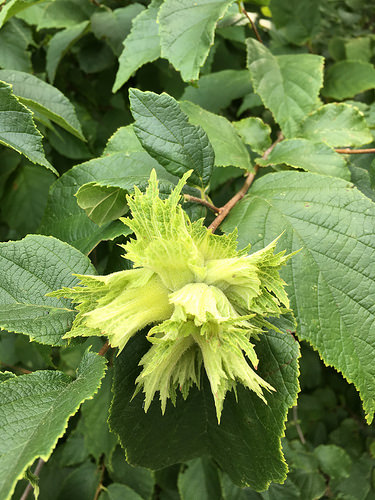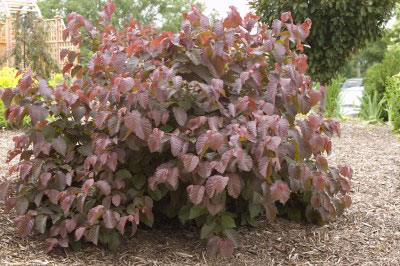Today, lets talk about a shrub I doubt you have found in the garden center, nurseries or other stores you usually buy your plants in, the American Hazelnut.
That does not mean you shouldn’t be adding it to your landscape. Especially if you are trying to create a garden sanctuary not only for you, but also for the wildlife we share our land with. Here are some of the reasons you should consider our obscure shrub:
- It provides a variety of wildlife food and shelter.
- It is a native to much of the US.
- It’s Fall color is an attractive yellow to orange to copper color.
- It has no serious disease or pests.
One more thing, it is a long-lived and productive edible nut bearing shrub!
American Hazelnut
Corylus Americana
Pronounced: KOR-rill-us uh-mair-rick-KAY-
The American Hazelnut is a relative rarity in garden and landscape settings. This shrub should be a staple wildlife garden plant in natural style gardens due to its excellent wildlife value, reliability and attractiveness.
It is also one of the few nut bearing native shrubs and is an excellent addition to your diet!


The American Hazelnut has been found in all counties of my state and probably a few of yours.

Habitats that the American Hazelnut grow in include upland forests, moist to dry-mesic woodlands, savannas and sandy savannas, moist to dry-mesic prairies and sand prairies, as well as fence rows.
Cultivation




American Hazelnut Wildlife Value:
A lot of different insects feed on the leaves, nuts, and stems of the American Hazelnut. These include leaf beetles, walking sticks, plant bugs, leafhoppers, moth caterpillars (including the Luna Moth (Actias luna).


The nuts are eaten by a variety of birds including Red-Bellied Woodpecker, Quail, Wild Turkey, Ruffed Grouse, and my favorite bully, the Blue Jay. Even the male flowers and buds of American Hazelnut are an important source of winter food during for the Ruffed Grouse and Wild Turkey.


The list of mammals that eat the nuts include the Grey, Red and Fox Squirrel, Eastern Chipmunk, and White-Footed Mouse. Deer and rabbits will chew on the browse on the twigs and leaves also, but usually don’t due ornamental damage to the plant due to its thick shrubby habit. Beavers will use it if it is grown near water.
Due to the American Hazelnut’s dense branching structure and large leaves, it provides excellent cover and ideal nesting habitat for many birds.


American Hazelnut Landscape value
American Hazelnuts are great plants for natural hedgerows as well as spacing throughout the nature inspired garden. They provide a medium leaf texture with a crisp green color that changes to an attractive yellow to orange in Autumn.
While they are not specimen shrubs, they are great filler plants that add that all important green color to the landscape. They are long-lived plants that have been known to live well over forty years. You will not want to site them in wet soil unless you want them to sucker a lot and spread.
Soil and Water Conservation district sales in early Spring are a great way to find cheap although usually very small plants.
Even plants started from seed can often bear nuts very early, three to four years is not unusual compared to the often decades of nut bearing trees. Like most plants they won’t bear a heavy crop every year, but instead every 2 or 3 years with smaller yields on years between.
Of course there are some selections by the Nursery industry, including the Purple Leaf Bailey Select (Corylus americana ‘Purpleleaf Bailey Select’) if you just HAVE to have one that is a bit more ornamental. Although note research has begun to find that purple foliage plants may not feed our native insects as well as green leaf plants and if you are planting this plant for its high ecological value you may want to reconsider.

American hazelnuts are easy to propagate, maintain, and harvest. The hardest part about adding them to your landscape may be finding a nursery that sells them!
James Heberling says
We live on the Pine River in Waushara County, Wisconsin. We have a bridge that goes across the River to a point and it does flood once in a while, mostly in the spring. The soils is sandy.
Will hazelnut shrubs grow there?
Heidi Stevens says
We planted one last year, and it is now about 3′ tall and 2′ wide. I had a rabbit eating the leaves this morning. How long do these shrubs need to grow, and how big do they need to get, so that rabbits eating the leaves will not harm the shrub? We did plant it, because we are trying to turn our yard into a sanctuary for wildlife.
In SE Wisconsin, we got ours through Johnson’s Nursery.
Jim says
I don’t know but it sounds like it is well on its way to being large enough that rabbits won’t be a big issue. I would use some repellent this Spring though.
Shawn says
We recently propagated 10 from seed and they are about 10″ tall as I write this. I have them in 12″ deepots and will most likely plant them this fall. Any special treatment needed to keep them alive in a pot over the winter? I am in upstate NY. A zone 5.
bob says
you mention that the corylus is easily propagated. I have a few plants that I first planted 30+ years ago. If I want to make starts available to other Kentucky native plant growers, how would I go about that?
thanks
Grammy's Grub says
Hi there! I’m in Central Kentucky. Did you have success with propagating?
Anne Edwards says
Hi! We recently built on family land in north east Texas, zone 8….Neil Sperry is our expert for Texas planting and I do not find them in his book…Will hazelnut trees survive Texas heat? Thank you!!! Anne
ranger rick says
how tall will they grow ?
Placidus says
I’ve been reading around for forever on this, but I haven’t been able to find an adequate answer. In England they are coppiced and the poles are used for fencing, bean poles, etc. Are the American varieties as good for this as the European, or are the poles not tall enough/thick enough ? I’d love to be able to have a reliable source of support poles for the garden.
bob says
make great poles…if you let them go for a couple of years you can have a straight 8′ x 1/3″ pole.
Wayne says
The New Hampshire State Nursery sells these as seedlings. I bought 5 years ago and they are now very productive.
http://www.nhnursery.com/online-tours/seed-to-seedling.aspx
Yanyra says
Prairie Moon sells them as bare roots.
https://www.prairiemoon.com/corylus-americana-american-hazelnut-prairie-moon-nursery.html
Garden Guy says
The State of Wisconsin is trying to develop Hazelnuts as a crop. I believe there are also few other States doing the same. I will add one of hybrids to my cottage garden. Thanks
http://www.driftless.wisc.edu/upper-midwest-hazelnut-initiative/
Jim says
Thanks for the info. I didn’t know about this but am definitely going to be reading up on it.
Bob says
Oregon produces 95%+ of US filberts (commercialized hazlenuts). Thousands of acres have been added in the Willamette Valley the last couple of years..they are replacing berries and grass seeds as a crop for Oregon farmers. (hemp is starting to take hold as well)
Holly says
Thanks for this info. Just collected some seeds and plan to plant them along the edge of the road. We shall see if I am successful.
Lala F. says
I wanted to add the Arbor Day Foundation has little ones for sale on their website. I haven’t found one around me.
Dotty Hartline says
Wherected can I buy hazelnut Plants? Can I start plants from seed?
Jim says
Retail nuseries sometimes carry these. If you are patient enough you can grow from seed.
Jeremiah says
This was good timing as I’ve been researching native shrubs to form a hedge. I had considered forsythia because of its size, hardiness and ease of propogation but found out they are not a good source of forage for honeybees. We have a corner lot with about 1 acre that is maintained as lawn. We feel pretty exposed so would really like a hedge that offers some privacy most of the year. Does the American hazelnut offer pollen or nectar for honeybees and other pollinators? I’ve really been considering the Redosier dogwood – do you have any thoughts on using them in this way? I really enjoy reading your blog. Blessings, Jeremiah.
Jim says
No pollen benefit for wildlife as they are wind pollinated. They can form nice dense twiggy growth that sounds like a terrific choice for your site as a screen. They will be a bit more effective in the winter as a screen then the dogwood.
You could certainly combine them with other shrubs that offer pollen or you could just underplant them with Virginia bluebells, etc. for pollinators like bumblebees.
I think they would be a great choice.
bob says
also notable that the forsythia is not native. I just dug up my whole hedge.